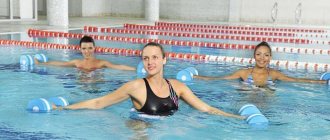The weight loss portal “Lose Weight Without Problems,” “keeping pace” with the information needs of its readers, cannot ignore such a pressing topic as, which (according to many) is an excellent medicine designed to combat excess weight. Despite the fact that many people know about the benefits of running, only a few are familiar with the basics of proper organization of jogging, and it’s a shame, because there are many important details, knowing and taking into account which can significantly increase the effectiveness of exercise.
Running for weight loss: components of successful training
You have probably more than once had to sadly watch the scales showing the same treasured kilograms, although you bravely starved yourself for a whole month (sitting at your desk, in front of the TV or monitor). Why didn't the kilograms go away? Yes, because you didn't move! Let's see what actions need to be taken in order for weight loss to occur through running.
- Be careful when choosing comfortable shoes
.
It is advisable to choose a loose-fitting tracksuit made from natural fabrics. Losing weight through running will be more effective if you purchase anti-cellulite shorts
. They not only help get rid of cellulite, but also stimulate sweating and fat burning. - If the lifestyle to which you are accustomed is not characterized by mobility, then before starting running exercises, consult a doctor
about the presence or absence of diseases for which exercise is contraindicated. - Offer running as an option for effective weight loss to a friend
(it’s more fun to do it together) or fill your phone/player
with “training” music
. - a forest park
as a place for jogging , where cars polluting the atmosphere with exhaust gases are extremely rare. Prefer a dirt road to asphalt terrain. - If you want jogging to lose weight in your legs to please you with its effect, train three to four times a week
, dedicating at least an hour to exercise. - Don't forget about changing the speed, rhythm and form of running
: let the jogger be replaced by side steps, and then you can run at a fast pace. Losing weight by running will help remove all excess from the hips, making them beautiful and elastic.
Remember that losing weight through running will take more than one day, so it is important to create the right exercise regimen, schedule a diet yourself or together with a nutritionist, and diversify running exercises with fitness, aerobics or swimming.
Most likely, it is no secret to you that regular running for losing weight in your legs is irreplaceable.
, because it is this part of the body (along with the stomach) that lends itself exclusively to systematic physical exercise.
If you are one of the lazy people who don’t want to leave their native land in order to go for a run, special treadmills installed in the apartment are exactly what you need. And a TV remote control or computer with your favorite music is always at hand.
How and when is the best time to run for weight loss?
If you want women to go crazy with envy when they look at your figure, running in the morning to lose weight will help you, and running, like any other form of physical education, has its own rules, which we’ll talk about now:
- To prepare your body for the upcoming run for noticeable weight loss and tone your muscles, do a warm-up
consisting of such simple actions as performing circular movements with your head, arms and pelvis, squats, alternately lifting your legs up (bent at the knees) and walking, smoothly changing first with a slow and then faster run. Pre-warm-up should take at least ten to fifteen minutes. After all, the body will begin to burn extra calories and weight loss through running will begin only after your muscles have warmed up sufficiently. If you are lazy, running will certainly benefit you, but not your figure. - During the first classes, do not overdo it
(so as not to lose the desire to train and not to “drive” an organism that is not accustomed to stress) and devote ten minutes to classes, during which you alternate jogging with walking. - Try to develop your own style of breathing
that does not allow you to choke during training. The ideal option is to inhale air through your nose as deeply as possible, and exhale through your mouth, taking two steps to the third. - After you have been training for a long time and notice that twenty-minute runs have become the norm for you, begin to change your running styles
for visible weight loss, for example, changing the speed of movement, raising your knees or touching your feet to your buttocks, moving sideways, etc. - end the workout
as smoothly as you started, moving from running to a fast step, and then to a slow one, to restore breathing. - To make your classes more effective, you should read the article “” and also purchase this wonderful accessory. A jump rope will help increase the load on the necessary parts of the body and distribute it correctly.
If you feel thirsty after a workout, don’t immediately reach for that coveted bottle of water, but wait half an hour and take a few small sips.
As for food, keep in mind that if you use running for effective weight loss, and not for building muscle mass, then it is recommended to eat after an hour and a half or two
after training - not before.
And one more thing: the site draws your attention to the fact that running in the morning for losing weight in your legs and stomach is more effective
than evening jogging, because the fats in the body are “burned off” only in the morning; in the evening, the energy accumulated during the day is mainly spent.
Contraindications for running
Losing weight through running is effective, and it is also very beneficial for your organs: the respiratory and cardiovascular systems are trained and become healthier thanks to your efforts. At the same time, in order for running to lose weight in your legs and stomach to benefit you and not cause harm to your health, it would not be superfluous to pay attention to the existing contraindications, which are:
- diseases of the cardiovascular system (congenital and acquired heart defects, hypertension with frequent crises, etc.);
- peptic ulcer of the stomach/duodenum;
- inflammatory processes observed in the body;
- phlebeurysm;
- bronchial asthma;
- flat feet;
- myopia;
- disruptions in the functioning of the endocrine system;
- presence of injuries and previous surgery;
- spinal deformation and pinched nerve endings.
Running on an empty stomach in the morning: benefits and harms for those losing weight
The benefits of running in the morning
Is running on an empty stomach in the morning good or bad? Discussions on this issue do not stop. No one can give a definite answer. But regarding the positive result after morning running on an empty stomach, we can answer in the affirmative: there is an effect. Next, we’ll look at all the pros and cons of this weight loss method, such as running in the morning on an empty stomach.
The positive effects of morning running on an empty stomach:
- Morning running on an empty stomach is stress, which forces our brain to activate all the body's reserves. In this situation, subcutaneous fat becomes a source of energy. Therefore, the benefits of morning running on an empty stomach are obvious for those who want to get rid of extra pounds.
- Morning jogging on an empty stomach helps avoid depression as it increases the production of endorphins. They are responsible for a good mood in the body.
- Regular morning jogging on an empty stomach makes waking up easy, and even after such a jog, excess fat continues to be burned until lunchtime.
Running on an empty stomach should proceed calmly, without fanaticism. Otherwise, all the benefits of this method of losing weight will be reduced to zero, because by regularly forcing your body on an empty stomach, you will overtrain and bring yourself to the point of loss of strength.
And getting out of this state will take a long period of time and will deprive you of the opportunity to run for some time in order to lose weight. First of all, people whose work involves heavy physical activity may encounter this problem.

The harm of morning jogging on an empty stomach
In addition to the benefits, running on an empty stomach for weight loss can also cause harm to the body:
- For people diagnosed with dystrophy, even light morning jogging on an empty stomach is contraindicated. The lack of the required volume of muscle and fat is dangerous for the functioning of the heart muscle, as well as for the functioning of the cardiovascular system.
- Diabetes mellitus is on the list of diseases for which running on an empty stomach is prohibited.
- The diagnosis of asthma is also on the list of diseases for which running is contraindicated.
- Running in the morning on an empty stomach can bring both benefits and harm, creating problems for people with gastrointestinal diseases. Those who have been diagnosed with a stomach ulcer need to be especially careful. Running on an empty stomach in the morning to lose weight can cause an appetite. Appetite is accompanied by the secretion of gastric juice, and the stomach is empty at this time, so the danger of exacerbation of an existing ulcer cannot be ruled out.
When running in the morning on an empty stomach, listen to how you feel. If you suddenly start to feel dizzy, feel nauseous or other signs of deterioration in your health, you should stop continuing your run.
Be sure to read: A selection of the most effective leg exercises
Lose weight by running: reviews
Running for weight loss leaves very different reviews about itself
, and most of them are positive. If you're interested in finding out whether the results represented by visible weight loss can be achieved, check out our readers' point of view.
- I’ve been practicing running in the morning to lose weight for a year and a half now, I’ve been struggling with my existing weight, and, oddly enough, successfully. Although during this time I lost only eight kilograms
, morning jogging has become a good tradition. Irina, 32 years old. - I've been running for a little over two years. The result is that I lost sixteen kilograms
. Satisfied. Marina, 47 years old. - At first I ran in the evenings, but over time I “restructured” and started running in the morning - before work. After training I feel great! Olga, 21 years old.
- For me, running for weight loss has given me simply impressive results
, so I run in the park in the summer and on a treadmill in the winter. The once blurred figure acquired feminine, slimmer outlines, which pleased me beyond words. Svetlana, 39 years old.
- Thanks to running, I not only lost two sizes
, but also restored my slightly shaky health. In the summer I run on the sports ground near my house, and in the winter on a treadmill, which I purchased specifically for this occasion. At first I was embarrassed to study - what if the neighbors saw and started laughing. But during my jogging, even one of my neighbors decided to join me. So run for your health!!! Larisa, 28 years old. - I have been practicing running to lose weight for five years now. I start jogging around the second half of April and continue until mid-October (if the weather doesn’t let me down). And although I won’t say that I had extra pounds, thanks to the exercises, my figure changed for the better - I became more fit
, or something. Since getting up early doesn’t appeal to me, I prefer to run in the evenings three times a week. Valentina, 42 years old. - When I “noticed” six kilograms of excess weight on my figure, I started doing body wraps, massages, visiting the sauna, but my actions were of no use. Then I decided to try running, and the result was not long in coming - in two and a half months the excess weight was gone
. And it took (neither more nor less) half an hour a day to run. Irina, 52 years old. - At first I ran from time to time, without thinking in any way about whether I was running correctly. There was no result. And then a friend told me how to train correctly, make the right movements with my hands, how to run, step and change the pace of running correctly. In five weeks of training I managed to lose 4.2 kg. Tatyana, 26 years old.
- I learned that to fight very heavy weight, fast walking and slow running are what you need, so I began to use this long-known method of losing weight. The modest results obtained in three weeks (three kilograms in the minus) do not upset me, but even motivate me, or something. Angelica, 19 years old.
If you want running to lose weight
has become your reliable assistant in the fight against excess weight, choose comfortable training shoes and clothes, take care of the proper organization of classes, and also write down the diet that you will follow. Believe me, preliminary preparation for jogging is one of the “building blocks” on which excellent results will subsequently be based.
All about running in the morning for weight loss
, why you should run in the morning, what to wear for jogging, where, what to eat before jogging, and a lot of reasoned facts about jogging in the morning.
Many people, when they step on the scale or look at themselves in the mirror, notice extra pounds on themselves and wonder how to lose a few extra pounds without much effort and harm to their health. So the answer is simple, with the help of running you will not only lose weight, but at the same time improve your invaluable health.
First of all, running activates almost all the muscles on your body and uses all previously unused capillaries; also, while running, your heart rate increases, which leads to an active fat burning process and in addition to training. These are all well-known facts about running, and now I will tell you why exactly in the morning and how exactly you need to run. Everything that will be written below follows from my personal experience.
The best time for running is from 6 to 8 am.
Why should you go jogging at this time? In the morning, our body’s reserve of carbohydrates that we have eaten over the past day is minimal, so during a run the reserve of carbohydrates that we have eaten over the past months will be consumed, i.e. subcutaneous fat which is what worries us. We get up 30 minutes before the start of the run, i.e. If we run at 6-00, we get up at 5-30. For what? To prepare yourself for a run. When we wake up, we go to the kitchen, make tea, then we go to wash, during which time the tea will brew. When losing weight and activating life processes in the morning, I recommend drinking green tea, since it contains minimal . Also, if you drink black tea before running, you will need to wait until the caffeine contained in these drinks is absorbed, and this is at least 30 minutes. However, drinking coffee on an empty stomach can make you feel uncomfortable. We don’t eat anything before a run, so that subcutaneous fat is burned, and not the buns that we ate on, i.e. We only drink green tea. We realized that one of the advantages of running in the morning is the low supply of carbohydrates in the body. There are also important advantages of running in the morning: the air is still slightly polluted, there are few people on the streets and, finally, you can see the sunrise. Now I’ll tell you about running equipment.
I'll start with the shoes. Shoes are a very important aspect for running, i.e. If you prefer to run around the stadium, where the surface is softer than on the sidewalks, then regular sneakers or any shoes with elastic soles will suit you. But if you are not attracted to the prospect of running in circles, then run on the sidewalks, i.e. from point A to B, but for this you will need special running shoes, they are sold in any sports equipment store. So why can’t we run in sneakers on the sidewalk? This is all due to the fact that the surface on which we will run is very hard and for this we will break our precious joints, primarily our knees, and special shoes with their shock-absorbing soles will help us avoid this.
For the greatest weight loss effect, we use a special warming belt and pants, sold in almost any pharmacy and sporting goods stores. Thanks to these things, the temperature of the places where they are worn increases, thereby more active burning of fat deposits in these places occurs. If possible, we dress as warmly as possible in order to sweat even more actively, while clothing should not hinder movement.
Before you start jogging, be sure to warm up your joints.
The running duration should be at least 25 minutes, since only after this time the activity of burning fat deposits increases significantly. For such a duration of running, calculate your strength by choosing the pace of running, music will help you with this.
What type of physical activity is accessible to everyone, does not ruin even a modest budget and brings maximum benefits in a minimum of time? Of course, running or walking for weight loss. Lose a couple of kilos or dozens, strengthen muscles or keep them in shape, overcome lingering blues - a regular jog will help you do all this. You just need to choose a suitable training program.
Do you feel like getting on a treadmill? Or maybe it’s even better - to change the stuffy gym with exercise equipment for fresh air in the park and a soft path? Don't delay! All you need is to decide on the duration and intensity of your training. After all, for different ages, body types and physical fitness, there is a “best” run for weight loss. In other words, the most useful.
It's no secret that runners over 50 or seriously overweight cannot complete long races on par with younger and leaner ones. You will have to approach this sport with caution. But this in no way means that light jogging will harm you. Against! Women who do everything often have better results than those who focus on strength training.
This universal sport helps not only to “shake off” excess fat reserves, but also:
- develop heart muscle;
- saturate the blood with oxygen;
- strengthen the immune system;
- restart metabolism;
- along with sweat, remove the notorious waste and toxins from the body.
So it's not surprising that after a few months of regular jogging, you'll need to completely update your wardrobe. Hoodie “covers for tanks” will be a thing of the past, and their place on hangers will be replaced by fitted dresses and tight trousers.
It’s backward to find your own type of load. If you feel that long marathons are not for you yet, start by running in place. It is quite suitable for losing weight in the first stages, the main thing is that you get off the couch! For those who don’t start to feel out of breath after the first 100 m, it makes sense to go to the nearest park and try interval running. Larks will happily jog along the quiet morning streets. For owls, such a feat may be overwhelming, but they can run around in the evening with no less benefit. Such a workout will ensure a sound sleep with the loss of many calories eaten during the day, as long as you do not end it in the refrigerator.
Tip #2 – start with 10 minutes and watch your body
Beginners often make the mistake of working out until exhaustion in the first days. The body becomes exhausted, poor health appears, and interest in sports is lost for a long time. Therefore, it is important not to burn out in the beginning. Approach the question of how much you should run carefully. If this is interval running, it is recommended to do 30-40 minutes. But increase the time gradually:
• 1 week – 10-15 minutes; • 2 week – 20-30 min.; • 3 week – 30-40 min.
During the first week you will not be very tired, but your body will “warm up” and become more resilient. Starting with a short workout is also easier psychologically: it’s easier to tune in to classes that last only a few minutes. When the body gets used to the stress and daily jogging fits tightly into the daily schedule, there will be no more psychological discomfort. On the contrary, playing sports will bring joy.
Listen to your body, after training you should feel strong, not weak. Monitor your pulse. The norm is 115-130 beats/min. There is a formula that can be used to more accurately calculate the heart rate: (220 - age - resting pulse) × 0.5 + resting pulse. For example, if you are 30 years old and your resting heart rate is 70 beats/min., then the following calculations are obtained: (220 - 30 - 70) × 0.5 + 70 = 130. Thus, the norm is 130 beats/min., It is not recommended to go beyond it. An excessively rapid pulse indicates a heavy load on the heart. In this case, it is better to slow down the pace - switch to slow running or walking.
It is important to develop the correct breathing technique; this is the key to endurance and comfort while jogging. The inhalation should be of medium depth, the exhalation should be deep. Breathe through your nose, maintain uniformity: 3 steps - inhale, 3-4 steps - exhale. Run in the fresh air, the best option is a park or forest. Choose a place away from the roadway, the air there is polluted, and while running a person breathes actively, and dust settles in the lungs.
During the first weeks, your muscles may ache. This is a good signal that you have done a great job and changes are happening in your body. But if the pain is very severe: aching, burning sensations appear, it is difficult to straighten your legs, then you have overdone it, the load was too high. Take a hot bath with sea salt and allow yourself to rest for 1-3 days. For your next workout, reduce the load to a minimum and continue to gradually increase. The body must get used to the new way of life. With regular exercise, the pain will go away, leaving only a pleasant feeling of flexibility and strength.
You don’t have to exercise every day, 4-5 times a week is enough. Be especially careful when starting exercise if you are carrying too much weight. Consult a trainer or doctor. In the first weeks, it is better to exclude running, replacing it with race walking. Too active movements will not be beneficial, you can get injured or damage your joints.
Running program for weight loss
So where do we start? From the walk!
- For the first 1-2 weeks, don’t expect sprinting achievements from yourself. 15 minutes of confident fast walking in the first lesson, 20 in the second and an hour of light jogging in the 14th will save your health and allow you to slowly increase the load to the desired level. Run 3-4 times a week, no more.
Monitor your condition. Falling to the ground after training in complete exhaustion and with the thought “shoot me” is unacceptable! Ideally, your heart rate should not rise above 130 beats per minute, and return to its normal pace no later than 30 minutes after training.
Be sure to stock up on a pair of headphones and pick up a cheerful one. It will be easier to run under her energetic accompaniment.
- Having gained experience and slightly strengthened your muscles, you can move on to a more difficult pace. But don't rush right into the quarry! For the first half of the workout, the usual jogging is maintained, and only after 20-30 minutes try to take a faster pace. This way the muscles will warm up and receive the necessary preparation for the effort.
Even if you really want to say goodbye to the pounds as quickly as possible, do not try to set Olympic records while running to lose weight. Exactly how much to run and how, your health will tell you, but under no circumstances overload your body for more than an hour. After 65-70 minutes, he will stop drawing energy from fat reserves and will start working on muscle tissue. Do you need slimness at this price?
Sample training program:
If you prefer to measure your workouts by distance rather than time, fitness experts offer this option: beginners run from 3 to 7 km, advanced athletes – 10-12.
- Experienced runners can use interval running to lose weight. It allows you to achieve greater effectiveness from your workout, and in less time. Its algorithm is not complicated. The first 100 meters you walk at a fast pace, the second you cover at an easy trot. In the third 100-meter dash you make a leap - you literally run to the limit of your capabilities. And finally, slowly run the last 100 m. Then take a short rest (1-3 minutes) and repeat the entire cycle. 25 minutes of interval running will replace a regular hour-long run.
By the way, keep in mind: if you have given it your all, calories continue to burn intensively for 2 or even 6 hours after training, when you are already fully occupied with your usual activities. Great, isn't it?
Important point! Maintain proper body position when running to lose weight. The photo demonstrates it quite clearly: the legs should not be completely straightened so as not to damage the joints, the arms should be bent at the elbows, and breathing through the nose. Don't raise your knees too high and don't throw your heels too far back, touching your butt.
Three Key Principles
Regularity
The optimal amount of training for a beginner: 3-4 times a week. For example, running on Monday, Wednesday, Friday and/or Saturday. On other days, rest or light exercises to strengthen the abs (torso crunches and/or planks) and legs (squats, lunges). This will allow the body to adjust to a uniform rhythm of work and rest.
If your life schedule is fluid, then train according to the following principles: the break between workouts should be at least a day and no more than three; It’s better to run twice every week than to run four times in one week and then do nothing at all for two weeks.

Gradual increase in load
Many people started running and quit after two weeks. Most of them neglected the golden rule of all training: you need to start with a small load, which your body will perceive as joy, and not as stress and punishment.
Intense walking is a good alternative to slow running if it is still difficult for you. Or if you are overweight (more than 10 extra kilos).
Remember that it is not the cool runner who immediately ran fast and a lot, and then did not go out for a second run because of chest pain, shortness of breath and the shock of the nervous system from such a “sport”. Cool is the one who started small. If you last ran at school/institute or if more than a month has passed since your last run, then start with walking training.
Walk one stop to transport or leave the car a little further from the office and take a walk.
For the first week or two, just walk at a normal pace. It is better to take two 10-minute walks a day than to run a kilometer in 6 minutes in one run.
Then move to a faster pace. With each workout, you can increase the distance covered by 100-200 meters. You will notice that these workouts are easy. There is no resistance to going outside just to take a walk.
If you are ready to jog a little, then start alternating between walking and slow jogging:
- Run slowly for 1 minute (pulse up to 120-140 beats per minute).
- Then walk actively for 3 minutes, helping yourself with your hands (pulse should drop to 100-110 beats).
- Repeat this so many times to feel warmth in your body, but not experience severe discomfort.
This regime gives the heart, blood vessels and lungs a moderate load and protects the joints. Does not overload the nerves - training occurs at an acceptable level of load.

The gradual increase in load is extremely important for the health of the immune system: the body needs to adapt to a new rhythm of work, because when we move at a higher speed than usual, all systems of the body need to readjust to a new regime. This is beneficial for the body only if the load increases smoothly and gradually. It is also necessary to do training regularly, as we wrote above. After long breaks, you will need to start from the beginning - with walking.
Then you can gradually increase the duration of the running segments and reduce the duration of walking. If you practice regularly, you will feel progress: breathing will become easier, the body will adapt to the alternating speed of movement. You will want to increase your overall training duration. You can increase the total number of minutes by 10% each week.
If the word running gives you a feeling of heaviness, pain and suffering, then you are running too fast. Slow down or walk briskly at a speed that makes the workout enjoyable.
With this approach, the issue of motivation to train will be automatically resolved. We all love to do what makes us happy.
Conscious plan
Think ahead and imagine:
- What days of the week will you train? What can affect the transfer of training? It’s best to put workouts on your calendar - this way there’s less risk of missing them due to other important things.
- Where will you train? Outdoors or indoors? What kind of surface will you be running on?
The answers to these questions will determine what equipment you will need to prepare for your workout.
For example, sneakers: for running on asphalt you will need sneakers with more pronounced shock absorption than for running on a dirt track or a treadmill belt.

For indoor activities, you need a lighter running uniform: a top/sports bra, a T-shirt/T-shirt and shorts/breeches.
Running outside usually requires the addition of a jacket, warmer pants, accessories, or even thermal underwear.
Pack your bag with your uniform the night before - and then you will definitely have a reason to be proud of yourself!
Evening jogging and morning jogging
To lose weight, it is important that you exercise. The timing of the races is a secondary issue. Although most scientists agree that evening workouts are more effective in terms of lost pounds, not all people can find the strength to do them after a hard day at work. In addition, morning “races” are considered more beneficial for the body. So choose the mode that you like best, without looking at other people’s opinions. In the end, there is nothing worse than dragging yourself to work out, cursing running, weight loss, and know-it-all scientists in your heart.
In general, the following time is considered optimal:
- in the morning - from 6 to half past seven;
- during the day – from 11 to 12;
- in the evening - from 5 to 7.
Do you easily get out of bed and feel a surge of energy in the first half of the day? Fabulous. Pull on your sneakers as soon as you wake up and work your way towards a slimmer waist and firmer thighs. It’s better to skip breakfast so that the body has nowhere to get energy from. Then, willy-nilly, it will take over its own “reserves.” An exception is made for hypotensive people and people with stomach problems: a light protein breakfast will not harm you for a full workout. Eat cottage cheese, a couple of hard-boiled eggs or a jar of yogurt.
You shouldn't overload on carbohydrates, even healthy ones. The body necessarily uses porridge, fruits and vegetables as a source of energy, preventing the consumption of adipose tissue, while protein will be used to build muscles.
The same goes for owls. For running in the evenings to lose weight to have an effect, fill your dinner with protein foods and do not get up to train immediately from the table. Of course, your meal doesn't have to be heavy. After a grilled steak with a plate of potatoes, the run risks being reduced to a couple of minutes from the table to the sofa.
Running in place
Typically, this type of running is chosen by people who do not have much time to train (mothers on maternity leave, people working from home, etc.).

With this type of running, you need to follow several rules: raise your legs high, pull in your stomach, keep your back straight. In order to see minimal results, you need to run 10-15 minutes a day.
Running for weight loss: reviews
Most runners note the benefits of regular training. Many people are surprised to realize that as a result of running, the abdominal muscles, which seem to be completely uninvolved in this process, are strengthened. (In fact, this is not true - proper training gives a good workout to many parts of the body, in addition to the legs.)
Those who are seriously involved in running to lose weight must warm up before and after training. After the final “jerk”, do not stop right away - walk at a leisurely pace for another 5 minutes, and then do a stretch for your legs and back. Judging by the reviews, just a couple of short exercises will save you from injuries during a run and pain the next morning after it.
Be sure to choose good sports shoes. Strictly on the leg so that it does not dangle while running. With a comfortable insole to avoid blisters and calluses. And, of course, a sports one, since it is created taking into account the upcoming loads on the legs and will allow you to keep your joints safe and sound.
Another piece of advice from experienced runners: get out into forested areas more often. The oxygen you get from such a run will make your workout even more effective.
And finally, if bad weather or other objective reasons prevented you from going for a run as scheduled, replace it and the day will not be lost.
Tips and reviews for running on an empty stomach in the morning

Should you run on an empty stomach?
Running on an empty stomach is a good way to burn fat. When running in the morning on an empty stomach, the body is poor in proteins and carbohydrates, and they are the sources of energy. Therefore, the body has no choice but to burn fat accumulations. This is the beginning of the weight loss process.
Those who have tried running on an empty stomach in the morning share their experience and give advice to beginners:
- Before starting your morning run, it is recommended to drink only a glass of water. It will be comfortable for the stomach and intestines, and there will be no calories.
- Eating before a morning run is not recommended for people prone to obesity. Untimely eating immediately causes increased insulin production. It also has the property of inhibiting the destruction of fat cells.
- Running on an empty stomach is harder than running after a small snack. After 2-3 kilometers, pain in the upper abdomen may appear. This is normal, the abdominal muscles are just tired and give a signal about it.
- If you experience abdominal discomfort, continue running and run a little more. From this time, fat burning begins.
- You shouldn't have breakfast right after your morning run either. Relax, stand in a soothing shower at a comfortable temperature, drink water. Half an hour after your morning jog, eat a banana, and an hour later it is recommended to start breakfast, eliminating fatty foods.
- Running in the morning on an empty stomach can last about 30 minutes. The degree of physical fitness of the person losing weight determines the further duration of the run.
- The intensity of your running should allow you to talk calmly.
Like all methods for losing weight, running on an empty stomach in the morning also has contraindications. These include gastrointestinal pathology, asthma, dystrophy and high obesity.
Must Read: Does Burpee Exercise Really Help Burn Calories Fast?
Contraindications to training
Running is beneficial for almost everyone. Only people who have:
- heart problems;
- severe chronic diseases;
- problems with vision, in particular the retina;
- those suffering from pressure surges;
- survivors of a heart attack or stroke.
In any case, consulting a doctor or fitness trainer will not be superfluous. And as soon as they give the go-ahead, you’re welcome to go for a run!
The question of whether running helps you lose weight has long been closed. Now this is the most accessible and effective way to combat physical inactivity and maintain your shape. When using various diets to combat excess weight, the achieved effect often goes away after some time, since it is achieved by removing excess fluid from the body. When a person runs, he burns calories that he gets from his own fat reserves. As you train, fat goes away and weight decreases.
The reason for this is that when jogging, all human organs and muscles are involved. The body begins to work in accelerated mode, the heart has to pump blood several times faster and deliver more oxygen to the cells. And this leads to an acceleration of intracellular metabolic processes, as a result of which the energy necessary for the breakdown of fats is released.
Running activates almost all muscles in the body, including the heart muscle. The load on different muscles is different.
The main load is felt by the muscles of the legs and buttocks.
They are involved in flexion and extension of the foot and knee, and regulate the movements of the hip and knee joints. The calf muscles play a role in lifting the leg when running.
The abdominal muscles and biceps are also involved in running, but to a lesser extent.
With regular exercise during jogging, the muscles become stronger and are always in good shape.
The body consumes the necessary energy from fat reserves accumulated on the hips, abdomen and other places. As a result of regular jogging, fat from problem areas disappears along with kilograms of excess weight.
If a person does not overeat, but eats properly, supplying the body with all the substances necessary for life, then he will lose weight faster. This weight loss will be sustainable.
Contraindications, pros and cons

before and after
You cannot go jogging if a person has:
- kidney diseases;
- heart problems: heart disease;
- disturbance of blood circulation and heart rhythm;
- phlebeurysm;
- hernia and diseases of the spine;
- hypertension;
- head injuries;
- oncology;
The benefits of running warm-ups for the body are not only in losing weight, but also in improving the health of the body as a whole.
They are helping:
- Increase the tone and strengthen the heart muscle, which, as a result of oxygen delivery, enhances the nutrition of all body systems.
- Strengthen the immune system and nervous system.
- Actively work all the muscles of the body and heal the joints.
- Give the body tone , fight colds, hypertension and shortness of breath.
- Fight depression.
- Get rid of excess weight and toxins.
- Improve cerebral circulation , which reduces the risk of atherosclerosis.
Failure to comply with running technique can cause injuries to joints and muscles if you start jogging immediately at an accelerated pace without prior preparation. In addition, people who are too heavy are not recommended to go jogging, because there is too much stress on the skeletal and muscular system.
It is better to first lose some of the excess weight in another way, for example, through diet.
Efficiency can only be achieved through regular jogging, the duration of which should be from 40 minutes to 1 hour. This regime is being reached gradually. Therefore, the result can be noticeable after about 1 month of jogging. During intense running, a person can spend 600–800 kcal per hour.
How many calories are burned?
There are no universal figures for calorie consumption during jogging. These are individual indicators for each person.
Calorie consumption depends on:
- From the physical endurance
of the body. - On the speed
of metabolic processes. - From body weight.
- From the duration
, speed and nature of the run.
With a slow metabolism, the result of burning calories will be insignificant.
With rapid metabolic processes, it is much larger, but weight is gained as quickly as it is consumed. The calories obtained with the latter, before jogging and eating food with fast carbohydrates and polysaccharides, are usually consumed within 40 minutes after the start of physical activity.
Then the body begins to use up its own fat reserves. Calorie consumption slows down, because when burning fat, more complex biochemical processes take place. With different types of load, depending on the nature of running and your own weight, calories are burned differently.
Running can be:
- amateur;
- jogging;
- sprint;
- interval;
- over rough terrain;
If a person weighs about 70 kg and runs at an average amateur speed of 8 km per hour, then he will spend approximately 600 to 1 thousand kcal in one hour of jogging. With other types of running, the calorie consumption will be different.
The choice must be approached individually based on the physiological characteristics of the body and the tasks set to achieve the desired form.
Jogging
One of the most effective ways to lose weight. This type of running helps remove cellulite in problem areas of the body, restore immunity and create muscle tone.
How to properly run to lose weight?
Running is a natural form of movement for humans. To achieve results in getting rid of extra pounds without harming yourself, you need to approach the process wisely and follow the rules and conditions that will allow you to successfully obtain the desired result.
Conditions:
- A preliminary warm-up should be carried out
, including warming up the muscles and joints of the arms, legs and back, as well as warming up the whole body. - The running load
, if it did not exist before, should be increased gradually from small, low-intensity runs, preferably jogging for no more than 20 minutes, gradually increasing the intensity and duration of the run. - Jogging
should be regular.
To start losing weight, you must follow the rules of jogging:
- It is necessary to change the type and speed of jogging.
For example, change running to walking or switch from jogging to intense running. Fat will begin to disappear when the load is maximum. It is better to switch to it after 40 minutes of preliminary leisurely running. - Maintain
correct posture. - Hands must be free.
- Legs must be placed
on the entire foot or from heel to toe; running on toes is excluded.
When exercising, you need to monitor proper breathing and pulse using. You should inhale through your nose and exhale through your mouth and monitor the rhythm of your breathing. The pulse should not exceed the permissible norm so as not to harm the body.
Running program
Detailed instructions for beginners:
- Jogging should be done in the morning
, not in the evening. - You should run before meals
, not after breakfast. - to take a shower
after training. - start your run
with a slow jog. - For jogging,
choose comfortable sports shoes. - Move to fast running
and changing its type with caution, excluding a sharp transition.
In order to get involved in training runs, it is recommended to create a kind of training plan, which is called a running program.
It should take into account the individual characteristics of a person, his age, general health, and opportunity for exercise.
For beginners, a universal program has been developed, which includes initial jogging with a minimum load with a gradual increase in the following days. In the first week of training, the workout consists of alternating 1 minute of running and 2 minutes of walking. The duration of the workout is 21 minutes.
Week 2 includes:
alternating 2 minutes of running and 2 minutes of walking for 20 minutes. In subsequent weeks, the duration of running increases and walking decreases. Gradually reach a full run throughout the entire workout.
It is better to use such a program individually, adjusting it to suit your capabilities.
Interval running
People achieve great results in losing weight when they include interval running in their exercise.
It is called interval because the speed of movement changes at different intervals of distance.
For example, if you jog the first distance of 500 meters, then the next 500 meters should be run intensely at the highest speed. Then go back to easy running or walking and then run again at maximum speed.
This type of jogging with interval loads is good for losing weight and training muscles.
Running on an empty stomach will help you burn fat correctly.

You have decided to lose weight and have chosen to run in the morning on an empty stomach. Immediately tune in to a morning jog lasting 30 minutes or more, plan your morning and start exercising. The first days, of course, will be difficult and even very difficult, but then the body will get into a rhythm and it will become easier.
As a new runner, to make getting started and moving forward easier, choose a training regimen that works for you. When choosing a jogging mode and location, use these tips:
- For morning running, the ideal option would be an uneven surface with descents and ascents; the steps of stairs are also suitable. When going up, metabolic processes accelerate, and on the descent you will have the opportunity to relax. With such a treadmill texture, you will get results faster.
- When running, you need to alternate loads evenly. You need to start your run with a brisk walk. After 10 minutes, you can switch to a light jog, and after 10 minutes, increase the pace and give the body maximum load. If you feel tired and have difficulty breathing, slow down and start walking again and restore your breathing. This type of running is called interval running.
- The jogging time for each is determined individually. There is no need to exhaust yourself, endurance will come with time, but for now listen to your body: if you are tired, rest. When losing weight by morning jogging on an empty stomach, the main thing is not to harm yourself.
- When jogging in the morning, the main thing is to breathe through your nose. Breathing should be rhythmic. Proper breathing will enable you to run longer distances.
- And, of course, morning running on an empty stomach means breakfast in the form of a glass of water and nothing more. You will be able to eat only after finishing your run, and then after 30 minutes.
If you find it difficult to choose a training regimen on your own, you can use the tables of standard plans for beginner runners.
Having analyzed all the pros and cons, we can say that running on an empty stomach for weight loss can be used as one of the ways to reduce excess weight. This will improve and strengthen your health, put your kilograms in order, and lift your spirits.
Just running in the morning on an empty stomach does not need to be turned into a daily obligatory duty. In this way, you can get stomach problems as a side result. An important factor in the process of losing weight is reducing calories consumed. For maximum effectiveness, running on an empty stomach can be supplemented with interval running. Run while having fun, and the results will be excellent.
Video: Is it useful to run in the morning on an empty stomach:
Shoes, clothing and food
An important task for successful training is choosing the right shoes and comfortable clothes:
- When choosing sports shoes,
you must take into account the specifics of the foot: flat feet or club feet, otherwise this can lead to injury. If there are such deviations, special shoes with increased shock absorption or enhanced foot support are selected. - It is better to try on shoes in the evening
, because during the day your feet lengthen a little. You cannot buy tight shoes; there should be a space of up to 1 cm from the end of the big toe. - Shoes should be appropriate for the type of running
you use when training. For example, shoes for sprinting should have thin soles and be lightweight, while shoes for rough terrain will require shoes that provide good traction and flexibility. - When choosing sportswear
, you should focus on comfort; it should breathe well, be light and allow internal moisture to pass through. - It is better to have several sets
of training tights or shorts and T-shirts. - When training in cold weather
, you need to wear clothes in several layers so that you can remove them partially as you warm up during training. Therefore, you need to choose clothes that are easy to remove.
To achieve good results in losing weight from running training, you must follow. It is necessary to exclude from the diet all fried foods, flour and sweets (read about how to overcome cravings for them), because they contain a lot of calories.
You should have dinner no later than 3 hours before bedtime. Fluid intake, especially plain water, should be increased to compensate for fluid lost through sweat during jogging. You can drink natural fruit drinks. Carbonated drinks and juices should be excluded from packages.
1.5 hours before training, stop eating food, and drink water only half an hour before training.
It is not recommended to eat immediately after a run; you must wait at least 2 hours.
Running for weight loss is not meant to burn calories!
Running for weight loss, how to run to lose weight? Since childhood, it has been drilled into our heads that running to lose weight is simply necessary. Is this so? What does the term “run to burn fat” actually mean? Is there a difference between running to lose weight? And where to do cardio for weight loss - on a track, an elliptical or an exercise bike, in the park?
To begin with, I’ll say right away - I myself practically don’t run at all. I’ll say even more - many famous athletes also really dislike cardio exercises. However, my blog is more for people who start a new life on Monday than for advanced athletes, and let me tell you everything in order.
So, if you watch my video blog, you know that to lose weight you must meet three conditions: 1. calorie deficit 2. No insulin spikes 3. fast metabolism.
We’ve covered this in detail and how easy it is to lose 15 kg in a couple of months in these two videos (one and two), and now we’ll focus on the first point. A caloric deficit means that you must consume less energy than you expend.
Ideally, the deficit should be no more than 10-15% and we can create it either by increasing the load (that is, spending) or reducing income (that is, cutting back on food). And the biggest mistake would be to think that running is designed to burn calories.
From the point of view of common sense, what is easier: run for 40 minutes on a treadmill and burn about 500kk or not eat one Snickers. (Snickers about 6.6km run). Therefore, I always insist that a calorie deficit must be created by cutting back on food, and not by increasing consumption.
Attention!
That's why - stop looking at the number of calories you burned. Running for weight loss uses a different mechanism. You need to look at your heart rate and the duration of the cardio load. And that's why:
Source: https://freshlife28.ru/bodybuilding/beg-dlya-pohudeniya/











